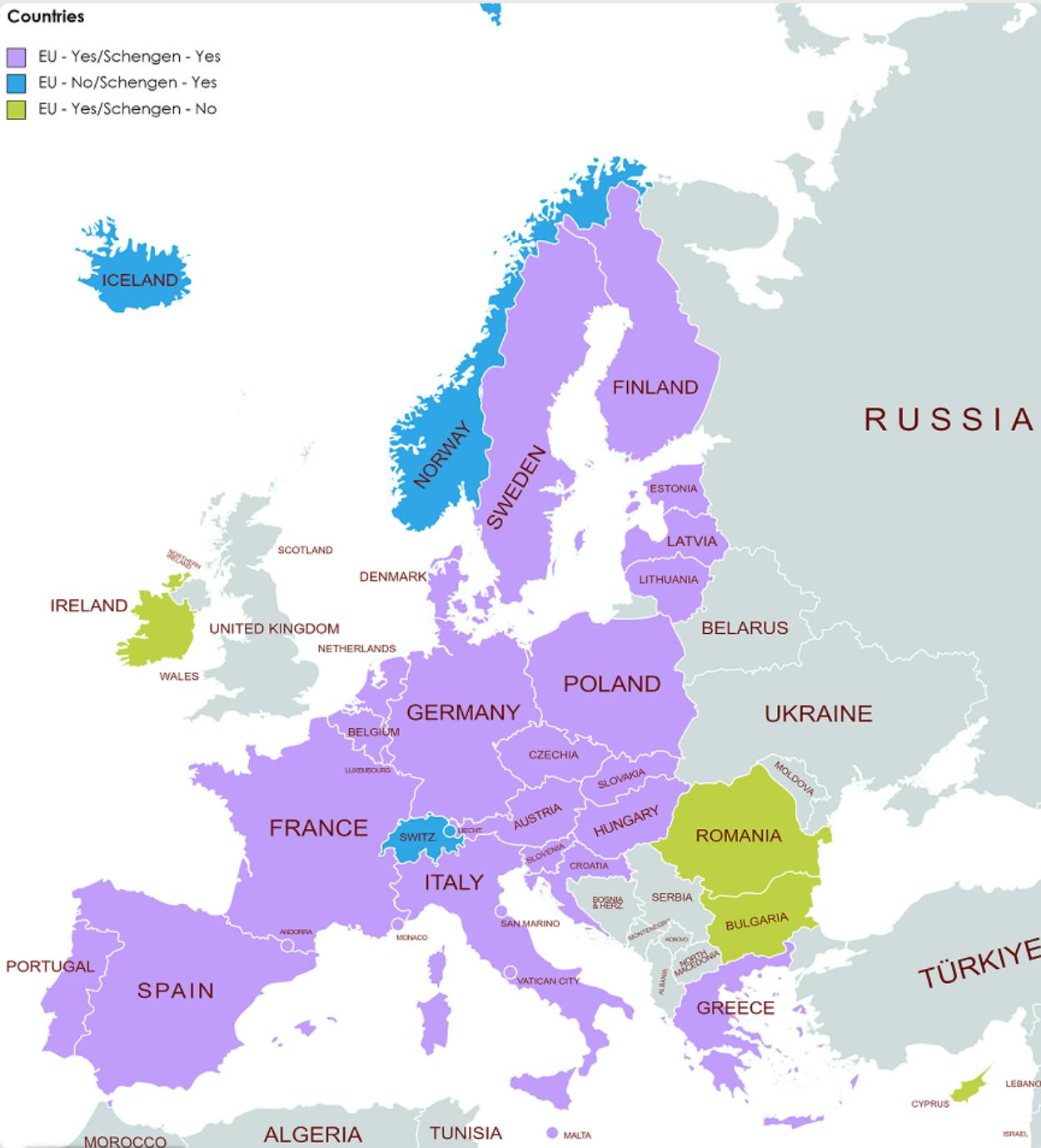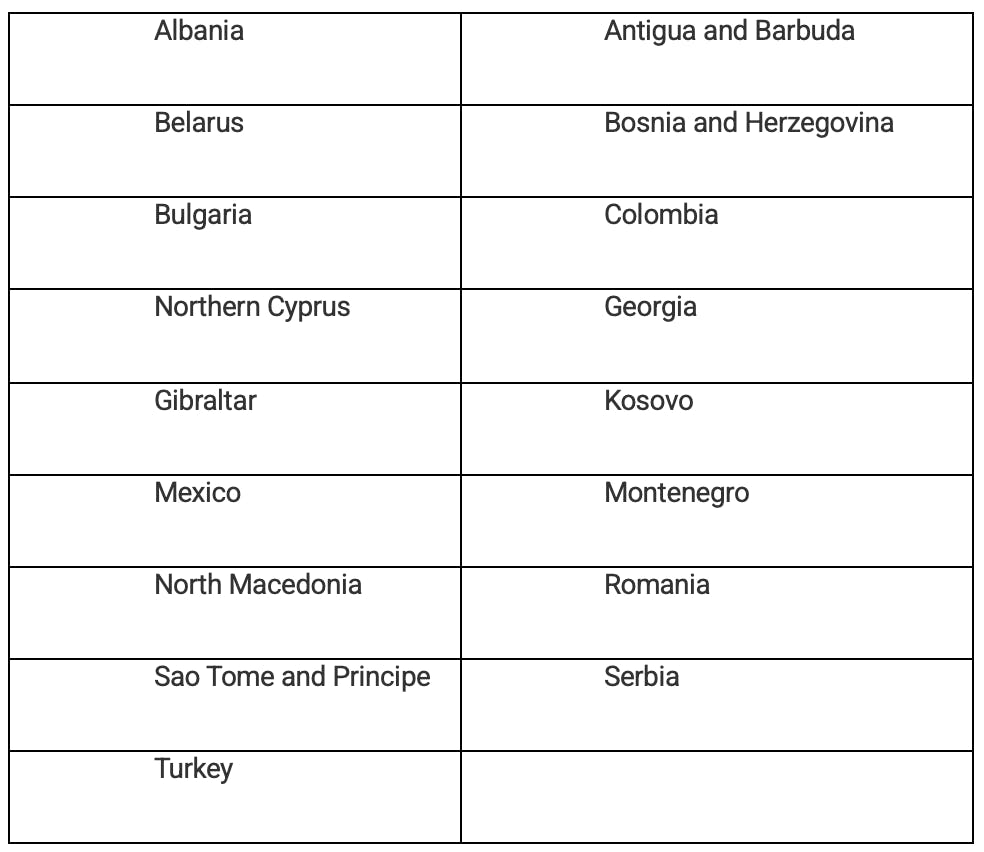
The 27 Countries Of The Schengen Area
Last Updated : 03 May 2024
30-Second Summary
Schengen countries are a group of European nations that have agreed to remove internal border controls, allowing for seamless travel within their territories.
The 27 Schengen Areas are Austria, Belgium, Czech Republic, Croatia, Denmark, Estonia, Finland, France,Germany,Greece, Hungary,Iceland,Italy,Latvia, Liechtenstein, Lithuania, Luxembourg, Malta, Netherlands, Norway, Poland, Portugal, Slovakia, Slovenia, Spain, Sweden, and Switzerland.
What Are Schengen Countries?
Schengen countries are a group of European nations that have abolished passports and other types of border control at their mutual borders. Travellers can move freely within these countries without encountering the typical border checks in non-Schengen areas.
The Schengen Agreement is signed by most European Union (EU) countries. However, certain non Schengen countries, such as Bulgaria and Romania, are signed but not yet active members and are only required to join in the future. In addition, Switzerland, Iceland, and Norway are not members of the European Union, yet they are part of the Schengen Area.
Schengen Countries List
Here is a Schengen countries map:

Additional Information
Liechtenstein, Switzerland, Iceland, and Norway, while not EU members, are part of the Schengen agreement and are associated with the EU's Schengen activities. This means they must adhere to EU decisions. Additionally, Norway and Iceland are members of the Nordic Passport Union.
The Schengen zone includes France's Caribbean islands and three European micro-states: Monaco, San Marino, and Vatican City. These territories and micronations have open or semi-open borders for visitors.
Despite opting out, Ireland and the United Kingdom still follow Schengen area norms, like other EU member states.
Understanding the Schengen Area
The Schengen area aims to create a unified space for travel, making it easier for tourists, business travellers, and students to explore Europe. It eliminates the need for multiple visas when travelling across these countries.
Benefits of the Schengen Area
Travelers in the Schengen area enjoy several advantages:
No passport checks at internal borders
Reduced waiting times at border crossings
Easier and more efficient travel
Enhanced economic cooperation among member countries
Schengen Agreement History
The Schengen Accord, formed in 1985 by Luxembourg, West Germany, Belgium, France, and the Netherlands, aimed to abolish border controls. This agreement initially removed border restrictions among these nations and proposed ending vehicle security checks.
In 1995, the Schengen accord introduced the Schengen visa system, enabling travellers to move freely across borders with just one visa for the entire area. This effectively created a unified travel zone, especially since most Schengen nations are also part of the European Union, aligning their rules.
Learn more about the intricacies of the Schengen Agreement.
Non-Schengen Countries Accessible With A Schengen Visa
Did you know you can enter other countries not in the Schengen zone using your Schengen visa if you get a Schengen visa to travel within the Schengen zone?
This makes it considerably easier for visa-required people to travel worldwide, including to countries in the European Union (EU). So why not use these visa-free rules and visit more non-Schengen countries than you originally planned?
Note: It's important to check the requirements and eligibility for these countries first.

Republic Of Ireland
The Republic of Ireland has yet to join the Schengen Area. However, there are many countries whose citizens do not need to apply for a visa to visit Ireland. These are the countries:
United States of America
Canada
Argentina
Brazil
Taiwan
South Korea
Japan, and more.
Although citizens of the countries listed above do not now require a visa to visit Ireland, it is quite likely that this will change soon, and they will need an ETIAS visa waiver to do so.
Romania
Like the rest of the countries on this list, Romania is not yet a member of the Schengen Area. On the other hand, Romania is a member of the European Union. As a result, the Romanian government has agreed to allow foreign nationals with a Schengen visa to visit the country for a limited time if they meet all the requirements.
Citizens of the United States do not need a visa to visit Romania for up to 90 days every 180 days (this is called the 90/180 rule). However, this will change once the ETIAS application is developed and functioning.
Residents from countries that do not now require a visa to enter Romania, such as the United States, will be required to apply for an ETIAS.
Bulgaria
On January 25, 2012, the Bulgarian government announced that all Schengen visa holders are free to enter and exit the country. There are, however, a few prerequisites that must be met:
Nationals of eligible countries must have a valid Schengen visa.
The number of entries and the time they can stay in Bulgaria cannot exceed the Schengen visa limit.
Those who have exceeded the number of entries and days allowed in the Schengen Area as specified on their Schengen visa will be denied entry to Bulgaria with that visa.
The holder of a valid short-term national visa for Ireland, the United Kingdom, Cyprus, or Romania is not permitted to enter Bulgaria.
All nationals from the 60 countries, including the United States, who do not currently require a visa for Bulgaria will be required to complete an ETIAS online application once the ETIAS travel authorization system is introduced.
Cyprus
Like the rest of the non-Schengen European countries on the list, Cyprus does not require citizens from more than 50 countries to apply for a visa before visiting any Schengen member states.
However, all visitors will soon need an ETIAS travel authorization.
What Are The European Union Countries Outside The Schengen Area?
The following European Union member countries have not signed the Schengen Agreement and are therefore not part of the Schengen Area:
Bulgaria
Cyprus
Romania
Ireland
What Are The Schengen Agreement Countries Outside The European Union?
The following countries are part of the Schengen Agreement despite not being members of the European Union:
Switzerland
Norway
Liechtenstein
Iceland
Is the United Kingdom Still Part of the Schengen Area?
Before Brexit, most nationals from visa-exempt Schengen Area countries could enter the UK without needing to apply for a visa if they were visiting for a short-term stay of up to 90 days within 180 days.
The ETIAS visa waiver will not be applicable for travel to the UK now that the UK is no longer a European Union member. However, ETIAS will be required for UK citizens visiting Schengen nations, according to the European Union.
At the passport control check, third-country travellers should show proof of sufficient financial means or an official current living address certificate. The following is a list of the many types of documentation that will help border control officials evaluate whether or not a passenger is eligible to cross the British border:
A bank statement or official letter from the applicant's employer with proof of wages can demonstrate the traveller's financial position and ability to support themselves in the United Kingdom.
Proof of legal residencies, such as a residential card or a bill that displays the traveller's name and address
Proof of employment or studies in progress
Travellers under 18 should bring a birth certificate and a letter from their parents stating the purpose of their trips, such as living conditions and financial position. In addition, a copy of the parents' passports may be required.
For citizens of visa-exempt nations, these are the general border-crossing restrictions. Standard visa applicants for the United Kingdom are required to provide similar proof. For more information, visitors should contact their local embassies or consulates.
Easiest Schengen Countries To Apply For
The prerequisites for applying for a Schengen visa are the same regardless of whatever consulate you go to, although the application process varies slightly.
Some countries like Latvia have fewer visa applications than a country like France therefore this might be an easier and faster application process.
However, some Schengen states have higher rejection rates than others.

Conclusion
Planning a trip to Schengen countries is an exciting venture, and understanding the Schengen area and visa requirements is crucial. With the information in this guide, you're well-equipped to navigate the visa application process and enjoy a hassle-free journey through Europe's most enchanting destinations. Bon voyage!
Government Sources
At Atlys, we thoroughly check every detail for precision. Our information is derived directly from reliable governmental sources, ensuring its genuineness. This article is designed using AI to provide clear and concise insights.
Frequently Asked Questions
Schengen area countries encompass a diverse group of nations in Europe. These include Austria, Belgium, Croatia, Czechia, Denmark, Estonia, Finland, France, Germany, Greece, Hungary, Iceland, Italy, Latvia, Liechtenstein, Lithuania, Luxembourg, Malta, the Netherlands, Norway, Poland, Portugal, Slovakia, Slovenia, Spain, Sweden and Switzerland.
Visas in Under a Week

The complete guide for the Egypt visa from the US
May 03, 2024Egypt visa for US citizens
In this blog, we'll cover everything US citizens must know about applying for an Egypt E Visa. We'll discuss the visa requirements, application process, processing times, and Egypt visa costs.

Kenya E-Visa Payment Issues And Solutions
May 03, 2024Kenya E Visa Payment Issues
Tips for what to do when you experience issues with your Kenya e-Visa payment process.

Get a Russian Visa for US Citizens Now - A Guide on How to Apply
May 03, 2024Russian tourist visa
Optimise your travel experience! Get your Russian visa for US citizens easily with this helpful guide. The post includes the application process and requirements.

Apply for a Bahrain Visa from the US - Bahrain E-Visa Application Process
May 03, 2024Bahrain visa for US citizens
Need a Bahrain visa? You're in luck! This post covers everything you need to know about the Bahrain e-visa including the application process and requirements.

Morocco e-visa: Requirements and Application 2024
May 03, 2024Morocco e-visa
US citizens can travel visa-free to Morroco. Discover the Morocco e-visa for US Green card holders. How to apply, eligibility, requirements, and the e-visa fee.

Myanmar e-visa— Application and requirements 2024
May 03, 2024Myanmar visa for US citizens
US citizens must apply for a Myanmar Visa. You can apply for an e-visa that allows a stay of up to 28 days. Click to learn the most important visa requirements!
Instant Visas

Maldives Tourist Visa: Entry and Visa Requirements to Maldives
May 03, 2024Maldives Tourist Visa
In this post you'll learn everything you need to about the Maldives Tourist visa. Including the requirements, costs and other types of Maldives Visas you can apply for.

St Lucia Visa | US Citizens and US Green Card Holders
May 03, 2024Travel To St Lucia
Discover the process of obtaining a St Lucia visa for US Green Card Holders. Learn entry requirements, application steps, fees, and visa validity.

Malawi visa for US Citizens
May 03, 2024Malwai visa for US citizens
US citizens enjoy visa-free entry to Malawi. Learn about fees, visa-extension, US green-card holder requirement and more